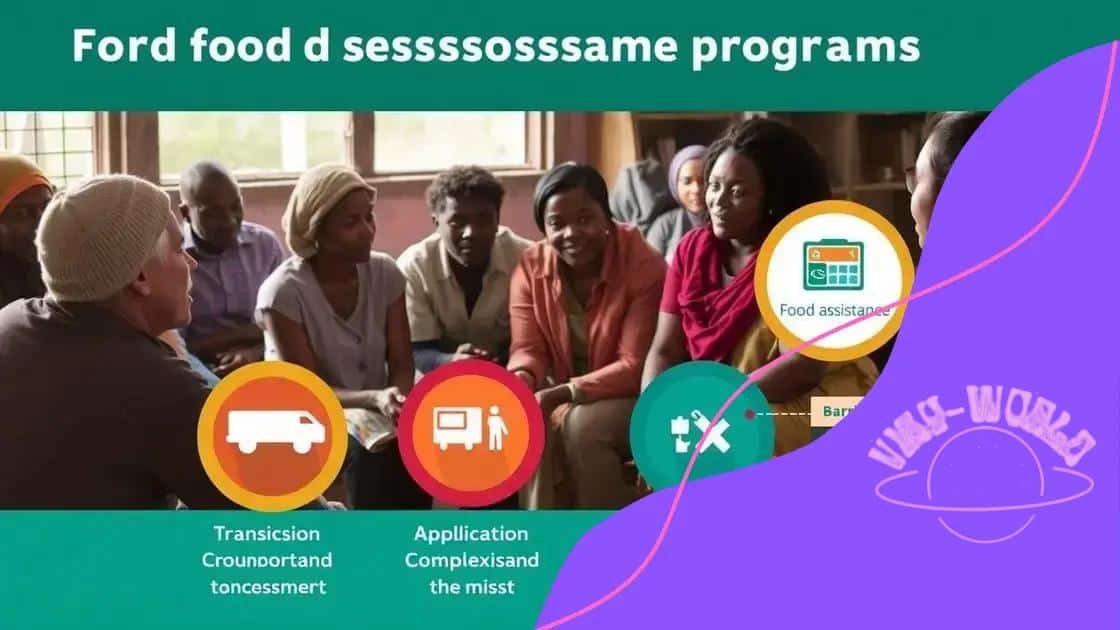Food assistance program reforms: what you need to know

Food assistance program reforms have significantly improved access and effectiveness, enabling more individuals and families to receive essential nutrition support and empowering communities to tackle food insecurity.
Food assistance program reforms are crucial for ensuring that those in need receive adequate support. Have you ever wondered how these changes affect local communities? Let’s dive in.
Understanding food assistance programs
Understanding food assistance programs is essential for grasping how they support individuals and families facing food insecurity. These programs aim to provide nutrition and resources needed to improve quality of life.
What are food assistance programs?
Food assistance programs are initiatives designed to help low-income individuals and families access sufficient, nutritious food. They come in various forms, including temporary assistance, ongoing support, and nutritional education.
Types of food assistance programs
- Supplemental Nutrition Assistance Program (SNAP): A federal program that offers financial assistance to buy food.
- Women, Infants, and Children (WIC): Provides nutritional support for pregnant women and young children.
- School Lunch Programs: Ensure children receive balanced meals during school days.
- Food Banks: Community organizations that distribute food to those in need.
Each program has unique eligibility requirements and benefits, so it’s crucial for individuals to research options accessible to them. Participation in these programs not only aids in providing meals but also helps lift families out of poverty.
Many families struggle daily to meet their basic needs. Food assistance programs often act as a lifeline, allowing them to focus on education and employment without the constant worry of hunger. People involved in these initiatives have reported improved well-being due to the support they receive.
Challenges in understanding food assistance
Despite the benefits, many still face barriers in accessing food assistance programs. Stigma and lack of awareness can prevent eligible individuals from seeking help. Additionally, navigating the application processes can be daunting.
Making these programs more understandable and accessible is essential. Community outreach and education can help demystify food assistance and encourage those in need to take advantage of available resources.
The impact of recent reforms
The impact of recent food assistance program reforms has been significant for many communities across the country. These changes focus on improving accessibility and effectiveness, making it easier for families to receive the support they need.
Positive outcomes of the reforms
Recent reforms have led to enhanced funding and streamlined application processes. These improvements mean that more individuals can access necessary resources efficiently. Food assistance has become much more responsive to local needs.
- Increased participation rates: More families are enrolling due to simplified eligibility criteria.
- Greater awareness: Community outreach programs have informed more people about available resources.
- Targeted support: Programs have adjusted to focus on specific community needs.
- Improved nutrition: With better access, families can afford wholesome foods.
Many beneficiaries have reported feeling more secure and stable due to these changes. For example, families can now focus on other critical aspects of their lives, including education and employment, rather than worrying about where their next meal will come from.
Challenges still exist
While the reforms are promising, some challenges remain. Certain populations, such as the elderly or those with disabilities, may still struggle to navigate the system. Additionally, despite increased funding, some areas face shortages in available resources.
For ongoing success, it’s essential to keep evaluating these programs. Regular feedback from participants can help shape future reforms, ensuring they continue to meet the needs of those they serve. Hearing real stories from impacted families showcases the importance of continuous improvement in the system.
Challenges facing food assistance programs

Challenges facing food assistance programs are significant and diverse, impacting many people’s access to necessary support. Identifying these challenges is crucial for ensuring that these programs work effectively for everyone in need.
Barriers to access
One major issue is that many eligible individuals do not participate in food assistance programs. This can be due to stigma, lack of awareness, or complex application processes. Individuals may feel embarrassed to seek help, thinking they will be judged for their situation.
- Lack of information: Many people are not aware of the programs available to them.
- Complicated applications: The paperwork can be daunting and confusing.
- Cultural barriers: Language differences can prevent effective communication and understanding.
- Transportation issues: Some individuals cannot reach food distribution sites due to a lack of transportation.
Even when people want to apply, logistical challenges may hold them back. Additionally, food deserts, areas with limited access to affordable and nutritious food, often complicate the situation even more. Limited access to supermarkets makes it difficult for families to find healthy options, increasing dependency on food assistance.
Ongoing funding issues
Another significant challenge is funding. Many food assistance programs rely on federal and state budgets, which can fluctuate. If funding decreases, programs might have to cut back on services, impacting the number of people they can support. This creates uncertainty for families who rely on these resources.
Despite these challenges, advocates continue to push for reform. They work to raise awareness about food insecurity and the importance of supporting food assistance initiatives. Community involvement plays a vital role in helping address these issues and ensure that everyone has access to the help they need.
Success stories from reform implementations
Success stories from reform implementations in food assistance programs highlight the positive impact these changes have had on communities across the country. By sharing these stories, we can understand how effective policies transform lives.
Real-life examples of change
Many families have benefited from the recent reforms, which have made accessing food assistance easier and less stigmatizing. For instance, in some cities, streamlined applications have significantly increased participation rates. Families that previously struggled to enroll in programs now feel confident accessing the help they require.
- Increased access for low-income families: Many families now receive support who previously didn’t have access.
- Health improvements: Nutrition education initiatives have helped families make healthier food choices.
- Community partnerships: Collaborations between local organizations have enhanced support systems for those in need.
- Empowerment through resources: Families report feeling more empowered to advocate for their needs.
For example, one individual shared how receiving assistance allowed her to focus on her education instead of worrying about where her next meal would come from. With the help of these programs, she graduated and secured a job, proving the lasting impact of effective food assistance.
Community initiatives driving success
Community-driven initiatives have also played a significant role in making food assistance more accessible. Local organizations have stepped up to fill in gaps left by formal systems. They offer help with applications, provide food directly, and educate those in need about their options. The spirit of collaboration often leads to creative solutions, helping many individuals who might otherwise fall through the cracks.
These success stories not only demonstrate the effectiveness of the reforms but also inspire hope. As communities come together to support one another, they build stronger foundations for future generations.
Future directions for food assistance initiatives
Future directions for food assistance initiatives hold great importance as communities work to improve nutrition and accessibility. Understanding the evolving landscape of these programs can help ensure that they continue to meet the needs of those they serve.
Focus on innovation
As challenges emerge, many food assistance programs are looking to innovative solutions. Technology can play a key role in streamlining processes and improving service delivery. For example, some organizations are exploring mobile applications that allow individuals to check their eligibility and apply for assistance quickly.
- Data analytics: Using data to better understand community needs can improve how resources are allocated.
- Online platforms: Virtual food banks and delivery services can help reach people in remote or underserved areas.
- Nutrition education: Programs are integrating education to empower families to make healthy food choices.
- Collaboration: Working with local businesses can introduce new opportunities for supporting food security.
These innovations can enhance efficiency and effectiveness, allowing programs to adapt to the changing needs of communities. As more people rely on food assistance, it is crucial to explore new strategies to keep pace with demand.
Advocating for policy changes
In addition to innovation, advocacy for policy changes is essential. Stakeholders are increasingly recognizing the importance of long-term funding to sustain food assistance programs. Advocacy efforts can bring attention to the challenges faced by low-income families and highlight the necessity for comprehensive solutions.
By pushing for policy reforms, advocates aim to secure more stable funding and enhance program flexibility. Engaging in dialogue with lawmakers can lead to meaningful changes in how food assistance is structured, ensuring it remains relevant and effective.
Ultimately, the future of food assistance initiatives depends on collaboration between communities, organizations, and policymakers. By focusing on innovation, advocacy, and collaboration, these programs can continue to evolve and serve those in need effectively.
In conclusion, food assistance programs play a vital role in supporting individuals and families facing food insecurity. Recent reforms have improved accessibility and effectiveness, allowing more people to benefit from these essential services. By focusing on innovation and advocating for policy changes, communities can ensure that food assistance initiatives continue to evolve and meet the needs of those they serve. Together, we can build a stronger support system that promotes health and well-being for everyone.
FAQ – Frequently Asked Questions about Food Assistance Programs
What are food assistance programs?
Food assistance programs are initiatives that help low-income individuals and families access nutrition and food resources.
How have recent reforms improved these programs?
Recent reforms have made programs more accessible by streamlining application processes and increasing funding to support more families.
What are some challenges faced by food assistance programs?
Challenges include stigma, lack of awareness, and funding issues which can limit help to those who need it.
How can I get involved in supporting food assistance initiatives?
You can get involved by volunteering, donating food or funds, and advocating for policies that support food security in your community.





